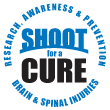
Shoot for a Cure works with the Ontario Neurotrauma Foundation (ONF) and its network of research partners, including the Ontario Spinal Cord Injury Research Network (OSCIRN), to fund research in the fields of spinal cord injury (SCI), secondary complications of SCI, traumatic brain injury, concussion, and acquired brain injury.
We are proud to be a part of the exciting developments at Dr. Tuszynskis CSRO supported lab at the University of California, San Diego. Dr. Paul Lu, a paraplegic and one of the researchers at the lab, has personal motivation in developing a treatment for spinal cord injuries. His area of focus is gene therapy and the use of growth factors to restore structure and function to damaged nerve cells. When a person suffers a spinal cord injury the nerves are damaged and the process of sensory organs sending messages through the nerves to the brain via the spinal cord is interrupted. The brain sends messages to various regions of the body muscles, glands, etc. This is referred to as the efferent neural pathway. The goal is to find a way to repair this damage and restore the function to the nerves. Multiple mechanisms contribute to the failure of spinal cord axon regeneration, including both a limited intrinsic ability of injured cells to regenerate, and a hostile environment in which axons can regenerate. Recently this lab has found that combination therapies that target both intrinsic mechanisms and the hostile spinal cord environment can successfully result in regeneration of injured motor axons into, and then beyond, sites of spinal cord injury. Supported by the CSRO, these researchers are now determining whether these regenerating motor axons make appropriate connections after regenerating, and whether these connections improve function. In the last year, they have identified optimal methods for targeting regenerating axons to neurons below the injury site (using gene therapy vectors that specifically target the neurons that have lost their inputs). In the next year, they will use these tools to determine whether regenerating axons succeed in restoring connections and function. Substantial progress has been made since we initiated the new research project examining motor axon regeneration and target re-innervation after spinal cord injury, generously supported by CSRO.
Riluzole as a drug has already been approved by the FDA, Health Canada, the Australian authorities and other countries for use in Amyotrophic Lateral Sclerosis (ALS). Riluzole acts on the sodium channels in cells, helping to prevent the accumulation of excess sodium in cells that results as a part of the flow of post-injury pathophysiological events after spinal cord injury. By doing this it has a protective effect. It also helps to modulate the neurotransmitter glutamate. Its use in acute spinal cord injuries has shown some promising results. Therefore our phase IIB/III trial of Riluzole in Spinal Cord Injury Study (RISCIS) is under way to evaluate the superior benefits of this drug in acute cervical spinal cord injury. It is exciting in that its neuroprotective properties also result in functional recovery. Such positive results from this drug trial have potential for rapid translation to clinical practice with significant best practice implementation and improved quality of life for a person who has sustained SCI. Preclinical studies in animal models have shown support for the use of this drug and continue to elucidate the mechanisms, thus providing in depth support and clear direction for this exciting clinical trial. This multicenter trial is currently recruiting at 10 sites in USA, 1 in EU, 3 in Canada, 2 Australia and few more new sites will be ready for recruiting. We are grateful to DOD, Christopher and Dana Reeve Foundation, AOSpine North America (AOSNA) for supporting the sites in Canada, USA and elsewhere. We are also grateful to Ontario Neurotrauma Foundation (ONF), Canadian Spinal Research Organization (CSRO) and Ontario Spinal Cord Injury Research Network (OSCIRN) for providing support for the three Toronto based teaching hospitals (Toronto Western Hospital, St. Michaels Hospital and Sunnybrook Hospital) to participate in this trial.
The work of Dr. Shucui Jiang and the team of researchers at McMaster University, Ontario, are making progress in the development of a therapy that involves harvesting intestinal cells for transplantation onto the spine of the individual. One of the most exciting aspects of this therapy is that it would eliminate any issues with donor rejection, as the cells would be coming from the individuals own body. This lab is determining whether cells from the intestine, called the Enteric Glia (EG) (nerve cells from the intestine), can promote the regeneration of nerve fibers through the injured spinal cord and make appropriate connections and thus increase the function of people with a spinal cord injury. They have now successfully isolated the GFP-gene transferred EG from rat intestine and also isolated EG from guinea pig teniae coli. A spinal cord surgery was performed to produce standardized spinal cord injury (SCI) in rats. The GFP-labeled EG has now been transplanted into the rats with SCI. What is now to be determined is the survival and migration of the GFP-labeled EG. The next step is to obtain EG from a human sample. The protocol that used for animal EG isolation will continue to be modified until the human EG is isolated.
Partner Foundation Websites
